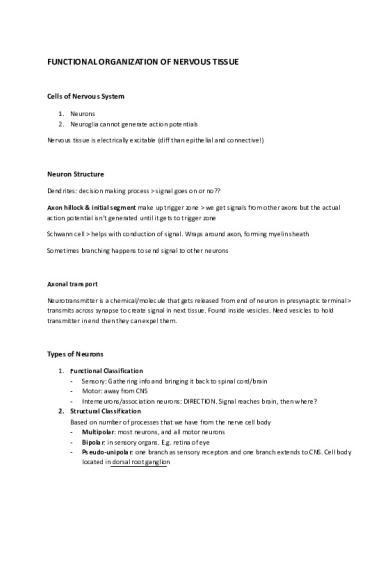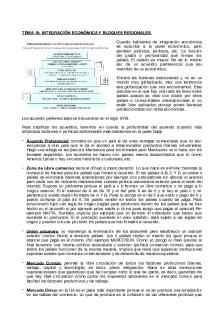Lecture notes, lecture 10 - Dr. krista howarth PDF

| Title | Lecture notes, lecture 10 - Dr. krista howarth |
|---|---|
| Author | Batoul Al |
| Course | Human Anatomy and Physiology |
| Institution | McMaster University |
| Pages | 3 |
| File Size | 64.4 KB |
| File Type | |
| Total Downloads | 53 |
| Total Views | 136 |
Summary
Dr. Krista Howarth...
Description
FUNCTIONAL ORGANIZATION OF NERVOUS TISSUE
Cells of Nervous System 1. Neurons 2. Neuroglia cannot generate action potentials Nervous tissue is electrically excitable (diff than epithelial and connective!)
Neuron Structure Dendrites: decision making process > signal goes on or no?? Axon hillock & initial segment make up trigger zone > we get signals from other axons but the actual action potential isn’t generated until it gets to trigger zone Schwann cell > helps with conduction of signal. Wraps around axon, forming myelin sheath Sometimes branching happens to send signal to other neurons
Axonal transport Neurotransmitter is a chemical/molecule that gets released from end of neuron in presynaptic terminal > transmits across synapse to create signal in next tissue. Found inside vesicles. Need vesicles to hold transmitter in end then they can expel them.
Types of Neurons 1. Functional Classification - Sensory: Gathering info and bringing it back to spinal cord/brain - Motor: away from CNS - Interneurons/association neurons: DIRECTION. Signal reaches brain, then where? 2. Structural Classification Based on number of processes that we have from the nerve cell body - Multipolar: most neurons, and all motor neurons - Bipolar: in sensory organs. E.g. retina of eye - Pseudo-unipolar: one branch as sensory receptors and one branch extends to CNS. Cell body located in dorsal root ganglion
Other cells: SUPPORTING CELLS 4 PART of CNS and 2 part of PNS -
Nervous system GLUE—non-neuronal (don’t generate action potential), they support/protect nerve cells They are smaller than nerve cells but there is a larger number of them than nerve cells Retain ability to multiply and divide!!!
CNS: 1. Astrocyte: - largest and most numerous - Provide STRUCTURE - Form “foot process” - Protection and release of chemicals - Highly regulating what can move thru/between endothelial cells > blood brain barrier - Help maintain chemical environment for nerve impulses – need proper amount of ions - Synthesis, absorption, recycle of neurotransmitters - Formation of synapses > bring dendrites and presynaptic terminals together to create junction between diff nervous cells 2. Ependymal cells: - Change shape between cuboidal and columnar - May be ciliated in some cases - Spaces within brain tissue - Specialized cells in brain form choroid plexus which produces cerebral spinal fluid (CSF) which helps move nutrients in brain and spinal cord 3. Microglial cells: - Smaller, thinner, and fewer process than astrocytes - Act as macrophage > phagocytic action (protection) - Inflammatory response 4. Oligodendrocytes: - Wraps form myelin sheaths - Very dense layer of lipid > insulation and helps conduct action potential PNS: 5. Schwann cells: - Can only wrap around ONE axon, unlike oligodendrocytes 6. Satellite cell: - Cell bodies protected by satellite cells - Support, nutrients, protection of cell bodies OUTSIDE of CNS
Myelinated: wrapping around multiple times around an axon. Oligodendrocytes in CNS and Schwann cells in PNS Node of Ranvier: single layer from Schwann cell so still protected but not by layers Unmyelinated: doesn’t wrap multiple times, axons just chill in a membrane of Schwann cell so Schwann can have multiple axons! Signals way slower
Multiple Sclerosis: Degradation of Myelin sheath > action potential slower > neural issues in muscle activation and senses
Organization of Nervous Tissue White matter: bundles of myelinated axons. In CNS: nerve tracts. In PNS: Nerves. Grey matter: not a lot of lipid (which makes the white colour) so the tissue looks grey -
In CNS when we have a cluster of nerve cell bodies and grey matter > nuclei Outer cortex and cerebellum and patches in brain connected together by white matter
In spinal cord: white outer and gray deeper like a butterfly transversely -
White matter (axons) carrying info up and down the spinal cord on the OUTSIDE, and the grey matter (cell bodies) is found deeper into spinal cord
*Cell bodies outside of CNS > ganglia. Inside > nuclei...
Similar Free PDFs

Lecture notes, lecture 10
- 5 Pages

DR Faustus Lecture Notes
- 1 Pages

Lecture notes, lecture 7-10
- 5 Pages

Lecture-notes - Lecture notes 1-10
- 82 Pages

241lecture 10 - Lecture notes 10
- 3 Pages

Chapter 10 - Lecture notes 10
- 17 Pages

Lab 10 - Lecture notes 10
- 3 Pages

Chapter 10 - lecture 10 NOTES
- 14 Pages

Inles 10 - Lecture notes 10
- 6 Pages

LecciÓn 10 - Lecture notes 10
- 8 Pages

Tema 10 - Lecture notes 10
- 10 Pages

Week 10 - Lecture notes 10
- 14 Pages
Popular Institutions
- Tinajero National High School - Annex
- Politeknik Caltex Riau
- Yokohama City University
- SGT University
- University of Al-Qadisiyah
- Divine Word College of Vigan
- Techniek College Rotterdam
- Universidade de Santiago
- Universiti Teknologi MARA Cawangan Johor Kampus Pasir Gudang
- Poltekkes Kemenkes Yogyakarta
- Baguio City National High School
- Colegio san marcos
- preparatoria uno
- Centro de Bachillerato Tecnológico Industrial y de Servicios No. 107
- Dalian Maritime University
- Quang Trung Secondary School
- Colegio Tecnológico en Informática
- Corporación Regional de Educación Superior
- Grupo CEDVA
- Dar Al Uloom University
- Centro de Estudios Preuniversitarios de la Universidad Nacional de Ingeniería
- 上智大学
- Aakash International School, Nuna Majara
- San Felipe Neri Catholic School
- Kang Chiao International School - New Taipei City
- Misamis Occidental National High School
- Institución Educativa Escuela Normal Juan Ladrilleros
- Kolehiyo ng Pantukan
- Batanes State College
- Instituto Continental
- Sekolah Menengah Kejuruan Kesehatan Kaltara (Tarakan)
- Colegio de La Inmaculada Concepcion - Cebu



